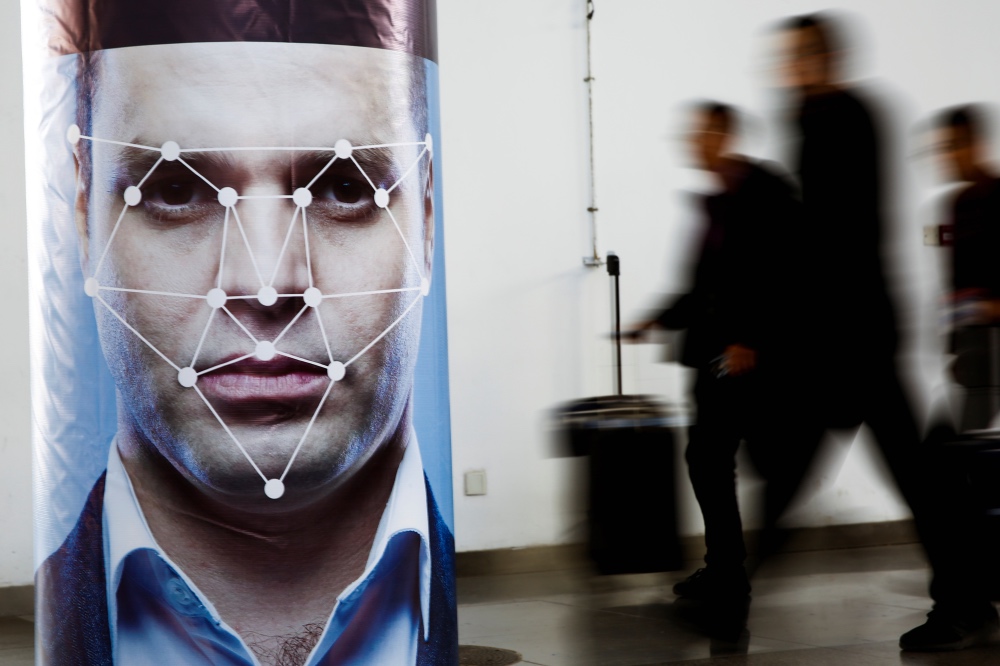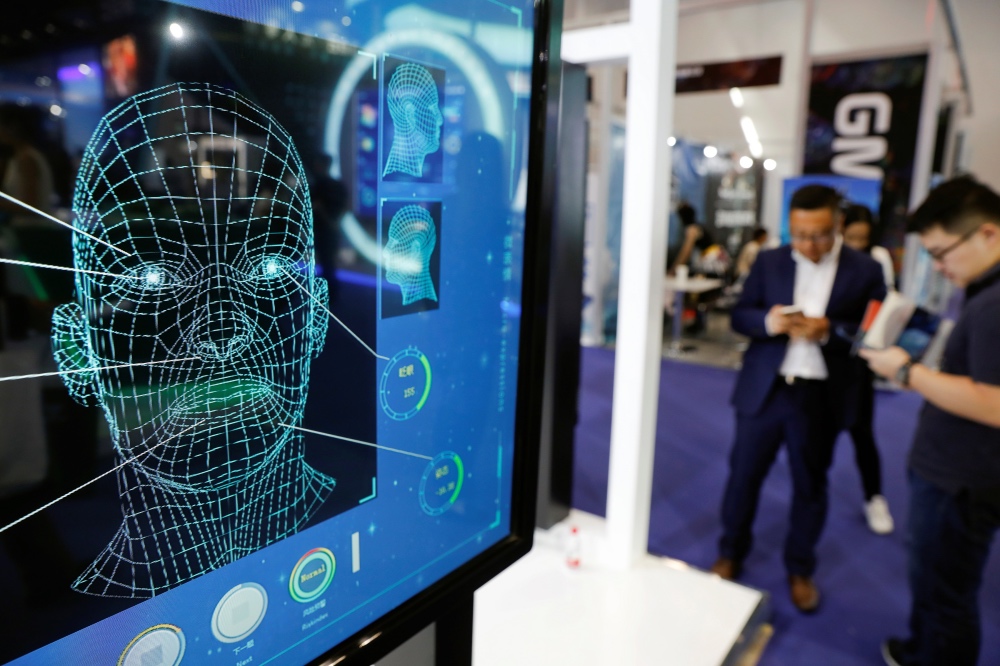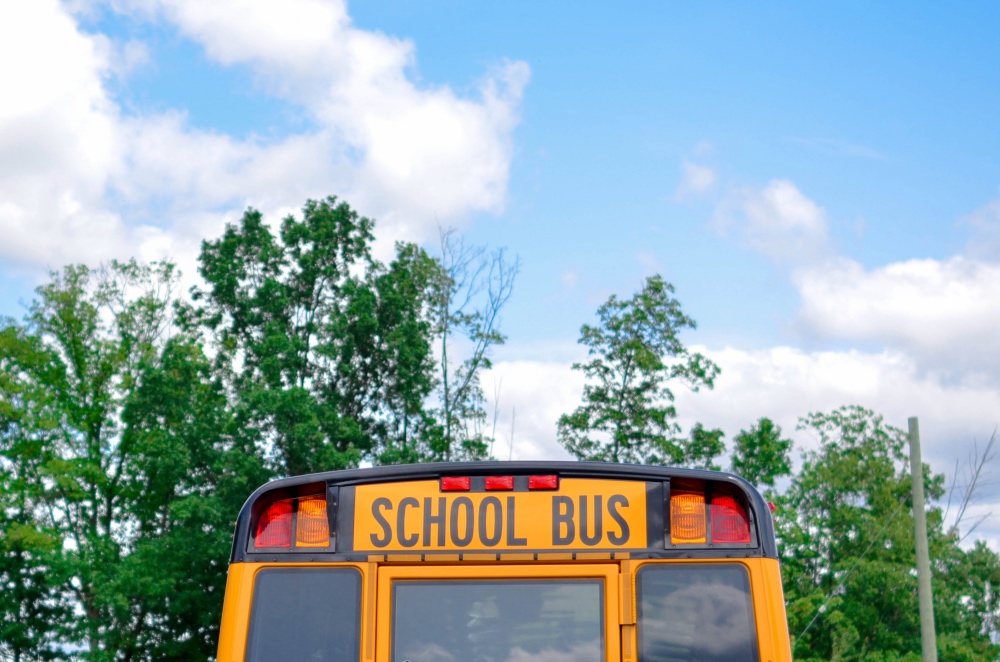
MATTHEW LAVIETES, writing for Thomson Reuters Foundation, reports…
New York City, US
Thomson Reuters Foundation
A lack of regulation about the use of facial recognition technology at US schools has alarmed education officials and lawmakers who say more research is needed before rolling it out widely.
Schools are fertile territory for the technology as high-profile profile shootings in recent years have exacerbated officials’ and parents’ fears about safety, security experts said.

People walk past a poster simulating facial recognition software at the Security China 2018 exhibition on public safety and security in Beijing, China, on 24th October, 2018: PICTURE: Reuters/Thomas Peter
“Right now, it’s like the Wild West [when it comes to facial recognition technology],” said Mike Matranga, executive director of security at Texas City Independent School District, which has installed facial recognition software at all of its schools.
“Any tool in the hands of the wrong person, is bad. That’s why we have to have good policies in place,” Matranga told the Thomson Reuters Foundation.
“Right now, it’s like the Wild West [when it comes to facial recognition technology].”
– Mike Matranga, executive director of security at Texas City Independent School District.
The rise of cloud computing and AI technologies have popularised the use of facial recognition globally, from tracking criminals to unlocking smartphones.
But as cameras appear at unlikely spots across the globe, activists raise fears about lost privacy and say society might be on the doorstep of a dystopia where Big Brother sees all.
Two US Democratic senators introduced a bill in February that would place a moratorium on federal use of facial recognition until lawmakers regulate it.
But regulation has yet to be introduced for its use in schools.
Proponents say the technology can enhance school security by identifying individuals deemed by schools or law enforcement as potential threats.
The software takes statistical measurements of people’s facial features.
It then compares them to databases of faces that schools have created – which typically include local sexual predators, students who have been expelled, parents who have lost custody of their children.
But critics argue facial recognition cameras have potential for abuse and should be thoroughly researched before rolling out the technology on minors.
“We shouldn’t be using our kids as guinea pigs,” said Monica Wallace, a New York state Democratic legislator.
Wallace introduced a bill late last year that would force schools in her state’s government to halt the use of facial recognition for a year. During that time, the bill proposes the State Education Department should study the technology thoroughly.
“Let’s not just take the vendors’ word that this is the best system in the world and that it’s going to keep our children safe. We have to look deeper into it,” said Wallace in a phone interview.
Schools should be investing in methods that have already been proven to promote safer environments, like promoting social and emotive learning, or hiring mental health counsellors and security officers, she said.

Visitors check their phones behind the screen advertising facial recognition software during Global Mobile Internet Conference (GMIC) at the National Convention in Beijing, China, on 27th April, 2018. PICTURE: Reuters/Damir Sagolj
But as state lawmakers weigh a vote on the bill, some schools in Wallace’s district have already implemented the technology.
Lockport City School District adopted facial recognition-equipped cameras early this year for safety reasons.
School district officials did not reply to several requests for comment.
Some school districts go further, using facial recognition to enforce disciplinary action.
When students are suspended at one of Texas City Independent School District’s, they are added to the system. If they are on school property during their suspension, the software alerts security officials.
Technology companies say it is beyond their control how schools use their products once a sale is completed.
“It’s really up to the schools to create the policy framework around how they’re going to use the technology.”
– Mike Vance, senior director of product management at RealNetworks.
“It’s really up to the schools to create the policy framework around how they’re going to use the technology,” said Mike Vance, senior director of product management at RealNetworks, one of the firms selling AI software to US schools.
“The schools own all of the data and rules,” he added.
Data privacy is a bone of contention for critics of schools using the technology, who warn that schools may not be equipped to stave off sophisticated hackers from stealing sensitive information.
“If someone steals your social security number, you can get a new one. You can’t get a new face,” said Evan Greer, deputy director of Fight for the Future, a digital rights advocacy group.
While acknowledging potential risks, proponents say incorporating facial recognition for safety takes precedent while school officials wait for the US Government’s input.
“It may be years before they act,” said Matranga, referring to legislators. “By that time there could be several mass shootings that have taken place.”

A school bus in the US – there have been more than 1,500 shootings at US schools between 1970 and 2019 according to the K-12 School Shooting Database. PICTURE: Element5 Digital/Unsplash
There have been over 1,500 shootings at US schools between 1970 and 2019, according to the K-12 School Shooting Database maintained by the Naval Postgraduate School, which is operated by the US Navy.
School shootings in 2019 and 2018 were nearly four times as high as the average rate per year since researchers began collecting the information.
In one of the deadliest mass shootings in US history, 26 people, including 20 children, were killed at Sandy Hook Elementary School in Newtown, Connecticut in 2012.
Jason Nance, a law professor at the University of Florida, has researched links between high-profile shootings and a trend of intensifying security at US schools.
Increased surveillance can foster hostile environments that may lead to even more disorder, according to a report he published in 2016.
The report said strict security measures send a clear signal to students they are “dangerous, violent and prone to illegal activity”.
“If that student misbehaves in some type of a slight manner because he or she is being watched very carefully, that student could be suspended again, expelled, or introduced to the justice system.”
– Jason Nance, a law professor at the University of Florida
These practices also create a “school-to-prison pipeline” for students with a prior history of disobedience, Nance said in an interview.
“If that student misbehaves in some type of a slight manner because he or she is being watched very carefully, that student could be suspended again, expelled, or introduced to the justice system.”
US college campuses are more reluctant than schools to introduce facial recognition technology, according to Fight for the Future.
The group got more than 50 prominent US universities to commit to rule out facial recognition for surveillance on their campuses.
The University of California, Los Angeles (UCLA) announced last month it had abandoned plans to install facial recognition surveillance systems on its campus, following a backlash by students.
Greer said the use of facial recognition technology should not be up to school officials alone.
“This should not be decided by some school official who maybe has their students’ best interest in mind, but might not have the expertise to know the potential harms of using technology like this,” said Greer.
“If left up to companies that make and sell this technology it would be everywhere,” Greer added.





